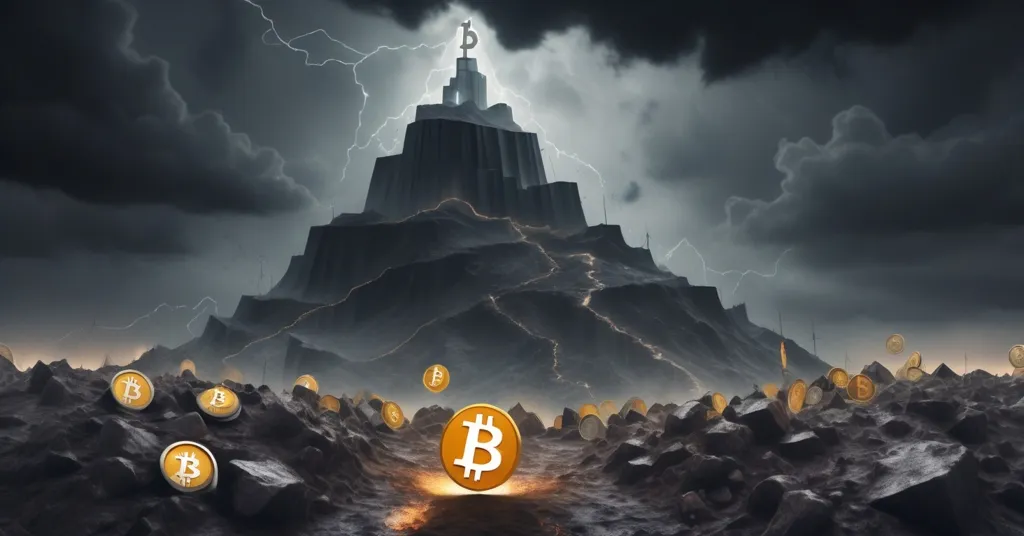Altcoin Season Index Crashes to 29: Market Bottom or Bitcoin Dominance Ahead?

Altcoin Season Index Plummets to 29: Crypto Market Bottom or Bitcoin Dominance?
The Altcoin Season Index has taken a nosedive, crashing from a high of 78 in September 2025 to a bleak 29 as of now. This staggering drop signals a brutal period for most altcoins, with only a handful managing to outshine Bitcoin in recent months. But amidst the carnage, could this low point hint at a market bottom and a potential rebound for altcoin fortunes?
- Index Collapse: Altcoin Season Index fell over 50% from 78 to 29 since September 2025.
- Struggling Altcoins: Only 29 of the top 100 altcoins outperformed Bitcoin over the last 90 days.
- Market Sentiment: Investor fear fuels a flight to Bitcoin, amplifying altcoin losses.
- Historical Patterns: Low scores have often preceded market bottoms and bull runs in the past.
Understanding the Altcoin Season Index
Let’s break it down for those new to the crypto game. Think of the Altcoin Season Index as a report card for the top 100 altcoins, grading their performance against Bitcoin over a 90-day period. Tracked on platforms like CoinMarketCap, this metric reflects market cap-weighted results (that’s the total value of all coins in circulation) to show whether altcoins are gaining ground or getting crushed by Bitcoin’s dominance (when BTC holds the lion’s share of investor attention and capital). A score above 75 screams “altcoin season,” a time of wild gains and speculative fever as smaller coins surge past Bitcoin. Below 25? That’s Bitcoin’s kingdom, where altcoins are little more than roadkill. At 29, we’re teetering on the edge of despair, with just a sliver of hope keeping the altcoin dream alive.
This index isn’t just a number—it’s a pulse check on market sentiment. It tells us where money is flowing, how much risk investors are willing to take, and whether the broader crypto space believes in the diversity of decentralized tech beyond Bitcoin. Right now, the message is loud and clear: confidence in altcoins is in short supply. For more details on the recent crash, check out this report on the Altcoin Season Index collapse.
Why the Crash Happened
Back in September 2025, the Altcoin Season Index hit a tantalizing 78, sparking buzz about an impending altcoin bull run. Social media was ablaze with hype, and it seemed every token had a shot at skyrocketing. Fast forward a few months, and we’re staring at a score of 29—a gut punch of over 50% down. What went wrong? A significant market crash on October 10, 2025, likely played a starring role. While exact details remain murky, whispers of a major central bank rate hike spooked the broader financial markets, triggering a sell-off that wiped out billions from crypto valuations in a single day. Altcoins, often more volatile than Bitcoin due to their smaller market caps and speculative nature, bore the brunt of this panic.
This wasn’t just a random dip; it was full-on crypto carnage. Investor fear took over, driving many to seek refuge in Bitcoin as the “safer” bet—or to exit the market entirely. The result is a measly 29 altcoins managing to outperform Bitcoin over the past 90 days. For context, Bitcoin itself saw a 4.32% decline during this period, a stumble that looks mild compared to the bloodbath among most altcoins. When the king falters, the smaller players often fall harder, and this crash has exposed just how fragile altcoin performance can be in 2025’s choppy waters.
Bright Spots in the Darkness
Amidst the wreckage, a few altcoins have pulled off near-miraculous gains, giving even die-hard Bitcoin maximalists a reason to sneak a peek. ASTER, a project backed by Binance, the heavyweight crypto exchange, posted an eye-popping 900% increase over the 90-day period. This surge likely ties to a recent high-profile listing or partnership push by Binance, showcasing how institutional support can propel lesser-known tokens even in a downturn. Similarly, ZCASH (ZEC), a privacy-focused coin offering anonymity features Bitcoin can’t match, also soared by over 900%. Its rally might reflect a renewed interest in privacy coins as regulatory scrutiny intensifies globally, with users seeking transactions shielded from prying eyes.
Then there’s Ethereum (ETH), the altcoin titan, which edged out Bitcoin with a 5.18% gain during the same timeframe. As the backbone of decentralized applications and smart contracts (self-executing agreements coded on the blockchain without intermediaries), Ethereum’s resilience speaks to its entrenched utility in the decentralized finance (DeFi) space. These outliers—ASTER, ZEC, and ETH—prove that even in a bearish market, innovation and niche use cases can still deliver staggering returns. They’re a reminder that altcoins often fill gaps Bitcoin doesn’t address, whether it’s privacy, programmability, or speculative hype backed by big players.
Historical Patterns: Hope or Hype?
Zooming out, there’s a flicker of optimism if we look at past trends—though crypto’s wild nature means nothing is set in stone. Historically, low Altcoin Season Index scores, especially below 40, have often marked market bottoms, acting as the calm before a storm of gains. Take the lead-up to the September 2025 rally: the index languished in similar doldrums before rebounding to that high of 78. Even further back, in late 2020, a comparable low preceded the 2021 bull run that saw altcoins like Cardano and Solana explode alongside Bitcoin’s rise. These patterns suggest we could be nearing a turning point.
But let’s not get carried away. History isn’t a promise, especially with 2025 throwing new variables into the mix—think macroeconomic uncertainty, evolving regulations, or unexpected tech disruptions. While the data offers a ray of hope, banking on a repeat performance is a gamble. Anyone claiming to know the exact bottom is peddling nonsense. Crypto thrives on cycles of fear and greed, and right now, we’re drowning in the former. Whether this low score sparks a rally or just prolongs the pain remains anyone’s guess.
Bitcoin vs. Altcoins: A Necessary Tension
As a staunch advocate for decentralization, I see Bitcoin as the bedrock of financial sovereignty—the digital gold that challenges the status quo of centralized banking. Yet, I can’t ignore the role altcoins play in this revolution. Ethereum’s smart contracts power a world of decentralized apps, ZEC offers privacy beyond Bitcoin’s transparent ledger, and even speculative projects like ASTER fuel experimentation that could yield tomorrow’s breakthroughs. This diversity drives effective accelerationism—our belief in pushing boundaries fast, even if it means messy failures along the way. Altcoin struggles are the cost of rapid innovation, a necessary chaos to disrupt traditional finance.
Still, let’s play devil’s advocate. Could Bitcoin dominance be a net positive right now? A BTC-led purge might weed out the countless altcoins with no real utility, refocusing the industry on projects that actually matter. For every Ethereum, there are dozens of tokens riding pure hype, draining investor capital without delivering value. While altcoin variety fuels creativity, a return to Bitcoin’s core mission of sound money could stabilize the ecosystem. This tension between BTC’s strength and altcoin experimentation is healthy—it forces us to question what decentralization truly needs to succeed.
Risks and Realities in the Altcoin Minefield
Let’s not mince words: the altcoin market is a damn minefield. The current index score of 29 is a stark reminder that betting on these smaller players is often a losing game. Scams, rug pulls (where developers abandon a project after hyping it and cash out), and unsustainable pumps plague this space. A sobering stat from CoinGecko shows that over 60% of new altcoins launched in 2025 lost 90% of their value within six months. That’s not just risk; it’s a slaughter for the unprepared. For every success story like Ethereum, countless investors get burned chasing the next big thing.
Beyond scams, there are broader threats. Altcoins’ higher volatility means they crash harder when sentiment sours, as seen with the October 10 meltdown. Regulatory crackdowns could target specific projects, especially privacy coins like ZEC if governments tighten the screws. And let’s not forget black swan events—unforeseen disasters that could tank the entire market. If you’re in altcoins for quick riches, good luck navigating this mess. Crypto rewards the patient and principled, not the reckless.
What’s Next for the Crypto Market?
This Altcoin Season Index drop isn’t just a number—it ripples through the broader push for decentralized technology. A prolonged downturn could slow altcoin adoption, with developers and investors pivoting back to Bitcoin or even abandoning crypto altogether. Yet, it might also spur focus on niches Bitcoin doesn’t serve, like DeFi or privacy, where altcoins shine. The fight for financial freedom continues, but its shape could shift based on how this plays out.
For those eyeing altcoins now, here’s a practical tip: focus on fundamentals. Seek projects with active development, real-world use cases, and transparent teams rather than chasing fleeting hype. Crypto isn’t a get-rich-quick scheme; it’s a long-term bet on a freer future. Whether this index low marks a bottom or just a pause before more pain, staying sharp and skeptical is your best defense.
Key Takeaways and Questions
- What is the Altcoin Season Index and why does it matter?
It’s a metric comparing the 90-day performance of the top 100 altcoins against Bitcoin, showing if altcoins are gaining or losing ground. It matters because it reflects market sentiment and signals potential bull runs or Bitcoin dominance. - Why did the index crash from 78 to 29 since September 2025?
Poor altcoin performance, exacerbated by a market crash on October 10, likely tied to global financial fears, dragged the index down, with only 29 altcoins beating Bitcoin recently. - Which altcoins are still outperforming despite the downturn?
ASTER and ZEC skyrocketed over 900% each, thanks to institutional backing and privacy demand, while Ethereum gained 5.18% against Bitcoin’s 4.32% drop. - Does a low index score signal an upcoming altcoin rally?
Historically, scores below 40 have often preceded market bottoms and rebounds, but 2025’s unknowns mean there’s no guarantee of a repeat. - How does Bitcoin’s performance impact altcoin sentiment?
As the market leader, Bitcoin’s declines often hit altcoins harder due to their volatility; only standout projects maintain confidence when BTC struggles. - How to interpret the Altcoin Season Index for crypto investing?
Use it as a gauge of relative strength—high scores suggest altcoin risk might pay off, while low scores like 29 signal caution and a potential shift to Bitcoin. - What risks should altcoin investors watch in 2025?
Beware of scams, rug pulls, high volatility, and regulatory threats—over 60% of new altcoins have tanked, making due diligence critical.
The Altcoin Season Index at 29 paints a grim picture, but the battle for a decentralized financial future rages on. Altcoins may be bruised and battered, yet their diversity and daring keep pushing the boundaries of what’s possible. Whether this marks the start of a new cycle or deeper pain, one truth holds: crypto bows to no one. Stay vigilant, keep your eyes on the fundamentals, and remember—the road to freedom is rarely smooth.



